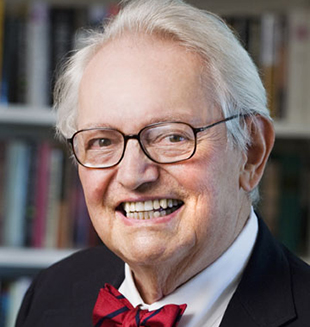

Charles P. Slichter (19242018)
National Medal of Science (NMS) recipient in 2007 “for establishing nuclear magnetic resonance as a powerful tool to reveal the fundamental molecular properties of liquids and solids. His inspired teaching has led generations of physicists and chemists to develop a host of modern technologies in condensed matter physics, chemistry, biology and medicine.”
Charles P. Slichter’s childhood was spent traveling among several college towns. He was born in Ithaca, N.Y., where his father was an economics professor at Cornell University, and moved to Cambridge, Mass., several years later. The Slichters spent their summers with extended family in Madison, Wis.; Slichter’s father’s father, for whom he was named, was the head of the Department of Mathematics at the University of Wisconsin (UW)-Madison. In Madison, Slichter used his grandfather’s tools to make model sailboats, which sparked a lifelong interest in woodworking and prepared him for hands-on work later in his career.
Slichter had been encouraged to pursue science and mathematics since childhood, but his interest was heightened after taking a physics course with a Boston University professor during his senior year at the Browne & Nichols School in Cambridge. Slichter excelled in the course, and decided to study physics as an undergraduate at Harvard University. While at Harvard, Slichter was introduced to John Hasbrouck Van Vleck, a fellow NMS recipient. Van Vleck's father, a mathematician at UW-Madison, had been hired by Slichter's grandfather. Van Vleck became Slichter's undergraduate advisor.
The attack on Pearl Harbor occurred shortly after Slichter enrolled at Harvard. With Van Vleck’s guidance, Slichter joined the Underwater Explosives Research Laboratory at Woods Hole, Mass., in the summer of 1943. The project was directed by E. Bright Wilson (fellow NMS recipient), a prominent chemist who had published a landmark quantum mechanics textbook with Linus Pauling (fellow NMS recipient). Slichter viewed his time at Woods Hole as remarkably beneficial to the rest of his science career. He gained valuable electronics experience designing and building oscilloscopes, and he developed a great respect for the breadth of knowledge possessed by the physical chemists at the laboratory, as well as their ability to explain concepts clearly and simply. While at Woods Hole, Slichter taught himself mechanics in preparation to take advanced courses upon returning to Harvard. Slichter cites this process as instrumental in teaching him how to get the most out of his physics courses and develop deep understanding.
After earning his bachelor’s degree in 1946, Slichter remained at Harvard to pursue his Ph.D. in physics, with Edward Purcell (fellow NMS recipient) as his advisor. Slichter’s experience constructing oscilloscopes at Woods Hole prepared him for his doctoral work, in which he designed and built an electron spin resonance rig. While he was working on his dissertation, Wheeler Loomis, who had been Purcell's boss at the Massachusetts Institute of Technology Radiation Laboratory, visited Harvard to recruit new faculty. Loomis offered Slichter a job at the University of Illinois (UI). Though hesitant at first, the appointment of Frederick Seitz (fellow NMS recipient), who had authored a well-regarded book on solid state physics, convinced Slichter to accept the position after he earned his Ph.D. in 1949.
Slichter became a full professor at UI in 1955, and remained on the faculty until his retirement from teaching in 1996. He is still an active researcher at UI, and his textbook, “Principles of Magnetic Resonance,” has been used in physics departments around the world for nearly five decades.
Image descriptions and credits
Any opinions, findings, conclusions or recommendations presented in this material are only those of the presenter grantee/researcher, author, or
agency employee; and do not necessarily reflect the views of the National Science Foundation.


